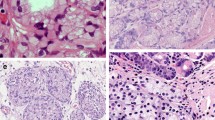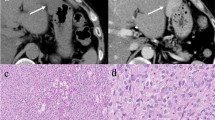Abstract
Purpose
Cancer cells are often found in adipose connective tissue separate from the primary lesion and outside lymph nodes on routine pathologic examination of resected gastric cancer specimens. To identify the anatomical relationship between such cancer cell spread and lymph nodes, we investigated the microscopic cancer cell spread in the mesogastrium (CSM) by the whole-section analysis of the mesogastrium.
Method
One thousand five hundred fifty-two sections of the mesogastrium obtained from 37 patients with gastric cancer were subjected. CSM is defined as the existence of cancer cell spread in the mesogastrium separate from the primary lesion.
Results
CSM was detected in three (8%) of the 37 patients. CSM was classified into three types. CSM was found in three of the 12 patients with advanced cancer, but not in 25 patients with early cancer.
Conclusions
CSM may occur in the mesogastrium separate from metastatic lymph nodes; therefore, we should pay particular attention to the potential existence of CSM in surgery for gastric cancer.



Similar content being viewed by others
References
Nakamura K, Ozaki N, Yamada T et al (2005) Evaluation of prognostic significance in extracapsular spread of lymph node metastasis in patients with gastric cancer. Surgery 137:511–517
Koike H, Ichikawa D, Kitamura K et al (2004) Perinodal involvement of cancer cells in gastric cancer patients. Surgery 135:266–272
Etoh T, Sasako M, Ishikawa K et al (2006) Extranodal metastasis is an indicator of poor prognosis in patients with gastric carcinoma. Br J Surg 93:369–373
Kumagai K, Tanaka T, Yamagata K et al (2001) Liver metastasis in gastric cancer with particular reference to lymphatic advancement. Gastric Cancer 4:150–155
Tanaka T, Kumagai K, Shimizu K et al (2000) Peritoneal metastasis in gastric cancer with particular reference to lymphatic advancement; extranodal invasion is a significant risk factor for peritoneal metastasis. J Surg Oncol 75:165–171
Abe N, Mori T, Takeuchi H et al (2005) Laparoscopic lymph node dissection after endoscopic submucosal dissection: a novel and minimally invasive approach to treating early-stage gastric cancer. Am J Surg 190:496–503
Japanese Gastric Cancer Association (1998) Japanese classification of gastric carcinoma. 2nd English edition. Gastric Cancer 1:10–24
Ishigami S, Natsugoe S, Tokuda K et al (2003) Clinical impact of micrometastasis of the lymph node in gastric cancer. Am Surg 69:573–577
Kahn HJ, Marks A (2002) A new monoclonal antibody, D2–40, for detection of lymphatic invasion in primary tumors. Lab Invest 82:1255–1257
Gang J, Sugiyama M, Hongfang T et al (2006) Distribution of lymphatic vessels in the neural plexuses surrounding the superior mesenteric artery. Pancreas 32:62–66
Yonemura Y, Endou Y, Tabachi K et al (2006) Evaluation of lymphatic invasion in primary gastric cancer by a new monoclonal antibody, D2–40. Human Pathol 37:1193–1199
Maehara Y, Tomisaki S, Oda S et al (1994) Lymphatic advancement to peritoneal dissemination and liver metastasis in gastric cancer patients. Anticancer Res 14:2755–2757
Ueno H, Mochizuki H, Tamakusa S (1998) Prognostic significance of extranodal microscopic foci discontinuous with primary lesion in rectal cancer. Dis Colon Rectum 41:55–61
Ueno H, Mochizuki H (1997) Clinical significance of extranodal skipped cancer infiltration in rectal cancer. Surgery Today 27:617–622
Mignano JE, Zahurak ML, Chakravarthy A et al (1999) Significance of axillary lymph node extranodal soft tissue extension and indications for postmastectomy irradiation. Cancer 86:1258–1262
Theunissen PH, Bollen EC, Koudstaal J et al (1994) Intranodal and extranodal tumour growth in early metastasized non-small cell lung cancer: problems in histological diagnosis. J Clin Pathol 47:920–923
Yamashita H, Noguchi S, Murakami N et al (1997) Extracapsular invasion of lymph node metastasis is an indicator of distant metastasis and poor prognosis in patient with thyroid papillary carcinoma. Cancer 80:2268–2272
Leemans CR, Tiwari R, Nauta JJ et al (1993) Regional lymph node involvement and its significance in the development of distant metastasis in head and neck carcinoma. Cancer 71:452–456
Baba M, Aikou T, Natsugoe S et al (1997) Lymph node and perinodal tissue tumor involvement in patients with esophagectomy and three-field lymphadenectomy for carcinoma of the esophagus. J Surg Oncol 64:12–16
Author information
Authors and Affiliations
Corresponding author
Rights and permissions
About this article
Cite this article
Nagatomo, A., Abe, N., Takeuchi, H. et al. Microscopic cancer cell spread in gastric cancer: whole-section analysis of mesogastrium. Langenbecks Arch Surg 394, 655–660 (2009). https://doi.org/10.1007/s00423-008-0427-y
Received:
Accepted:
Published:
Issue Date:
DOI: https://doi.org/10.1007/s00423-008-0427-y




